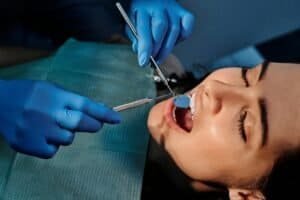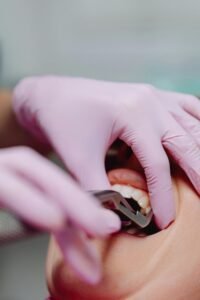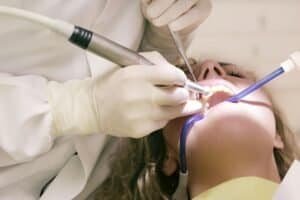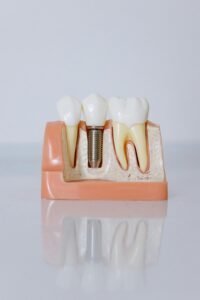Process Of Teeth Removal

Contents ⇓
-
What Is Tooth Extraction
-
Reasons For Tooth Extraction
-
Preparation For Tooth Extraction
-
Treatment Options
-
Pre Operative Instructions
-
Tooth Extraction Procedure
-
Replacement Options for Extracted Tooth
What is Tooth Extraction?
Extraction of a tooth refers to the surgical procedure where a dentist or an
oral surgeon removes a tooth. From its socket in the jawbone. Dentists typically
recommend extractions for severely damaged, decayed teeth, or those causing
issues like pain or infection. During the surgery, dental professionals meticulously
use specialized equipment to reduce discomfort.
A. Reasons For Tooth Extraction :
Some of the most authentic reasons for an extraction of a tooth are:

1. Severe tooth decay:
Severe tooth decay, or advanced or deep decay, occurs when decay progresses
deeply into the tooth, affecting the inner layers such as the dentin and pulp.
It can lead to intense pain, infection, and eventual tooth loss if left untreated.
Treatment typically involves root canal therapy or tooth extraction.
2. Gum Diseases:
Gum diseases, such as gum disease and periodontitis, lead to bacterial plaque buildup
along the gum line, resulting in inflammation, bleeding, and sometimes tooth loss.
Improper oral hygiene, smoking, and specific health conditions can increase risk.
Timely treatment is key to stopping severe damage and maintaining overall oral health.
3. Impacted Wisdom teeth:
As the last set of teeth in the back corners of the mouth, are known as impacted
third molars. They generally appear between ages 17 and 25, (teenage) but can
cause problems like pain and infection if there’s not enough space for them to
grow properly. Extraction may be necessary in such cases.
4. Crowding :
Crowded gums occur when there is insufficient space in the mouth for proper
alignment of all teeth. Crooked( where the teeth cannot fit into the jaw) or
shifting out of proportion, can cause the teeth to be. Overcrowding can
lead to issues such as difficulty brushing teeth, poor fit, and the risk of dental
problems. Treatment may include restorative ( regenerating) dentistry such
as dental implants or tooth extraction.
5. Trauma:
Trauma refers to any injury or damage to the teeth, mouth, or face as a
result of an accident, fall, sports injury, or other event. Trauma can result
in broken, dislodged, or lost teeth, and emergency dental care will be
needed to assess and treat the injury and prevent further complications
6. Filed Root Canal Treatment:
If the previous tooth remains showing signs of infection or pain, root canal
treatment is not successful. This can be due to a lack of springs, inadequate
sanitation, or recontamination(the process of making something dirty) of the
treated area. Symptoms may include persistent pain, inflammation, or rash.
Retreatment or extraction may be necessary to correct the problem.
B. Preparation for Tooth Extraction

Dental X-rays for tooth extraction
Dental Examination and X-Rays:
1. A thorough dental examination is necessary to understand the condition of the
tooth and its surroundings before extraction.
2. The patient and dentist usually initiate a discussion about any symptoms,
concerns, or previous dental history.
3. While undergoing examination, the dentist will observe and examine the affected tooth
and adjacent tissue for signs of decay, infection, gum disease, or other abnormalities.
4. One can gently examine the area to measure the extent of any damage or disease.
5. The dentist often takes dental X-rays as well as conducts a dental examination to
obtain detailed images of the tooth as well as the gums. X-rays of the adjoining bones
can reveal hidden issues like tooth decay along with bone decay Specific diagnostic
techniques can reveal an abscess throughout routine examination that may not be
visible in other ways.
The most common types of dental x-rays used in tooth extraction are :
a. Periapical X-rays:
Which focuses on a specific tooth and its gums,
b. Panoramic X-rays:
Which provides a better view of both the mouth and gums,
Generally, dental examinations and X-rays play a key role in the planning
and preparation of the tooth extraction procedure.
C. Discussion of Treatment Options:
1. Extraction vs. Preservation:
The first decision is whether tooth extraction is necessary or if there is another
treatment to preserve the tooth. In cases of severe degeneration, infection,
or trauma, we cannot preserve the tissue or organ, The best option for
prevention of further complications may be extraction.
2. Types of Extractions:
Depending on the complexity of the case, various findings may be considered.
With a brace, you can remove visible toothpicks that are simple in design from
your mouth. On the other hand, tooth extraction surgery is necessary for crowded
teeth or teeth with strong root canals.
3. Sedation Options:
While considering sedation options is a key issue for both patients and practitioners,
the quality and safety of sedation techniques are vital along with costs. It is a comfort during
surgery, When doing a tooth extraction, the dentist can apply their sedation technique by
intravenous (IV) or by inhalation to decrease the feeling of the tooth itself, and its vicinity.
For example, those who require the most urgent care that is dental, or the highly
complicated tasks may be noticed and treated immediately, determine the types of sedation
techniques demonstrated by methods such as oral sedation, nitrous oxide, or IV sedation.
4. Replacement Options:
For replacement of the lost functions of the tooth to improve both aesthetics and function.
Strategies such as dental implants and bridges, to name the unspeakable, could enable the
patient to regain the ability to smile unrestrictedly.
Bridges or partial dentures may be considered by the dentist about the patient’s specific
demands unless stated otherwise. Preferences during the consultation, the dentist would
be able to enlighten you on the various procedure choices, the advantages, and the disadvantages.
Generate pros and cons, make comparisons, and come up with a solution together with potential risks.
5. Preventive Measures:
The preventive tactics are to accelerate recovery and avoid bad endings after termination.
Will be discussed. This can include brushing and flossing directions, information about a
required diet, and recommendations on what to do to stop the disease from returning.
D. Pre-operative Instructions
1. Medical History Check:
Have your physician give your dentist a complete medical history record including
all medications that you are taking to allow the dentist to provide the best possible care.
For instance, if you have some allergies, previous surgeries, or disorders, you should know.
This data will assist the dentist in carrying out the procedure and make stipulations
on the aftercare.
2. Fasting:
A specific period of fasting may be required before extraction depending on the
sedation used during the procedure. In general, you should avoid eating or drinking
anything for at least 6 to 8 hours before your appointment to minimize nausea or
complications during cooling down.
3. Medication Use:
If you are taking any drugs or medications, follow your dentist’s instructions to
continue or temporarily stop taking them before eliminating them. Some
medications, such as anticoagulants, may need to be adjusted to minimize
intraoperative bleeding.
4. Smoking and Drinking:
Stay away from smoking or drinking alcohol in the hours leading up to your timed
elimination, as these elements can interfere with the cure and increase your
risk of complications
5. Postoperative Care Plan:
Discuss postoperative care instructions with your dentist, including pain management
strategies, dietary restrictions, and guidelines for oral hygiene after extraction of Gauze pads,
painkillers, etc. so that you are ready to use them at home prepare the necessary supplies
in advance.
If you have dental anxieties or fears about the extraction procedure, share your
dental concerns with your dentist. They can offer reassurance and recommend
relaxation techniques or sedation to help you feel comfortable during your
appointment. Following these pre-operative instructions will help ensure a
smooth and successful tooth extraction procedure, setting the stage for a
speedy recovery and optimal oral health outcomes.
E.Tooth Extraction Procedure

Step-by-Step Guide to the Procedure:
1. The tooth extraction treatment is a common dental practice used to remove damaged,
decayed, or impacted teeth, usually essential for pain relief and total oral health.
2. It starts with the injection of local anesthesia for numbing a specific tooth
so that the patient feels free without any pain during the tooth extraction process,
by holding an infected tooth, the patient experiences some sought of weight while
removing the specific tooth, the dental surgeon takes off the tooth by using a small
instruments so that it can be easily extracted.
3. More complicated cases may require surgical extraction, where the dentist may cut
into the gum or bone to access the tooth, particularly for damaged teeth.
4. After the completion of tooth removal, detailed post-care instructions should help
minimize discomfort, stop infection, and promote healing, managing a smooth recovery for the patient.
F. Replacement Options for Extracted Teeth
Options for Tooth Replacement (Implants, Bridges, Dentures)

Nowadays, numerous choices help in preserving function and appearance after teeth removal.
1. Dental implants are a type of treatment that is permanent and natural-looking.
This is a result of the artificial dental roots being surgically placed onto the jawbone.
2. Implants that are not removable, such as bridges, standing for the teeth that have
been missing, are placed in two or more units, or detachable units.
3. The dentures are removable dental devices that replace great portions of missing
units, thus being highly compatible and low-cost.
Conclusion
Tooth extraction can be essential for preserving oral health when other treatments
aren’t important. By understanding the treatment and following post-care advice,
patients can stop complications and improve healing. Immediate extractions can
relieve pain, reduce infection risk, and support a healthier, more comfortable
smile.
https://absoluteinformation.com/drinking-water-for-your-skin/

